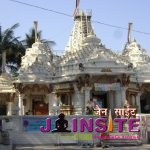SRI SINHAPURI TIRTH
PRESIDING DEITY AND LOCATION :
Sri Shreyanshnath Bhagwan in white color, seated in lotus posture and of height 30Cms (Shve) and
Sri Shreyanshnath Bhagwan in black color, seated in lotus posture and of height 75Cms (Dig).
The former is located in the village of Hiravanapur and the latter in Sarnath Char Rasta.
ANTIQUITY AND SALIENT FEATURES :
History of this shrine commences with the 11th Tirthankar Sri Shreyanshnath Bhagwan.
In the pre-historic period when the soul of Nalinigulma having completed his two previous incarnations entered the womb of Vishnudevi, the wife of king Vishnu who ruled this area, Vishnudevi had dreams in her sleep indicative of the birth of a Tirthankar and after the pregnancy period was over, she delivered a son with the sign of a rhino. (According to Digamber traditions the name of the queen was Venudevi).
Gods in the heaven led by their chief Indra celebrated this event of the birth of the Tirthankar with great éclat and pomp and in the king’s court also appropriate celebrations were held. The son was named Sri Shreyanshkumar.
On attaining youth, Sri Shreyanshkumar was married and crowned. Several years thereafter during the period of his reign, he decided to take Diksha. He then gave away in charity all his wealth in the course of one year previous to Diksha and renounced the worldly life and entered the order in the garden of one thousand mango trees. Then wandering as a monk for one month, he returned to the same garden and commenced intense and deep meditation under a “Tanduka” tree which finally resulted in the total destruction of his four “Ghatia” Karmas and his attainment of Keval Gnan on Maha Krishna 3. (According to DIgamber tradition, this happened on Maha Poornima). In this way this place had the good fortune where four Kalnayaks viz, Chyvan, Janm, Diksha and Keval Gnan of Bhagwan Sri Sheyanshnath took place.
Today this place is known all over the world as Sarnath which it is believed has been colloquialised from Shreyanshnath because no history is available as to how else the word Sarnath came to be coined. Here there is an eight cornered ancient stupa (solid dome) 103 feet high and believed to be 2200 years old set up and got constructed by a king called Priyadarshini, belived by Gods. According to Jain traditions, it is king Samprati, grandson of Emperor Ashok, who got this stupa built in commemoration of Bhagwan Sri Shreyanshnath’s four Kalnayaks at this place. King Samprati has used this word “Priyadarshi”, sometime even “Devanampriya” (beloved by Gods) wherever his name has been referred to and the latter is particularly of the Jain tradition. At present, this stupa is being looked after by the Archeological Department of the government and it is stated that “perhaps the stupa was got built by emperor Ashok”. Research is really important in this connection so that the actual truth can be known.
There are inscriptions available from among archeological excavations in which references has been made to Jain religion. If proper research is done on the local gardenof deers (mriga-udyana), true history will be available.
Fa-hi-yan, the Chinese traveler of the 4th Century has described this place. Hu-en-sing, another Chinese traveler of the 7th Century has also done the same.
This place was under the control of Mohammed Gazni in the 11th Century.Thereafter Rani Kumardevi wife of Govindchandra, the king of Kanoj had got built here a “Dharmachakra Jin-Vihar” (a residential resort for Jain travelers in glory of Jain religion). The temples here were badly damaged by Kutub-ud-din, the commander of the army of Shah-bud-din Ghori in Vikram year 1194 and there is reference that only two stupas were saved in this pillage and destruction. At present, there is only one Swetamber temple, one Digamber temple, one stupa and one Buddha temple.
This place is holy as it has the good luck of having four Kalnayaks of the present 11th Tirthankar Sri Shreyanshnath Bhagwan. The stupa is magnificient, ancient and unusual and beyond description. The government of India having given due recognition to its three lioned pillar and accepting the pillar as the state symbol has not only enhanced the prestige and importance of this place but has done a rare honour to “Sraman Sanskriti” (Jain culture and philosophy). There are no other temple nearby.
According to Buddha traditions, Lord Buddha gave his first sermon at this place to his five disciples. Buddhist literature refer to Rishipatan and Mrigadan in this connection.
APPROACH – ROUTE :
This place is 8Kms away from the railway station of Banaras Camp, from where buses and taxis are available. Near Sarnath Char Rasta there is the Digamber temple. In Hiravanapur, about 1.5Kms from Sarnath, there is the Swetamber temple. Cars and buses can go right upto the temple.
AMENITIES FOR JAIN PILGRIMS :
Near the temples, there are Swetamber and Digamber dharamshalas for lodging where water and electricity are available.
MANAGED BY :
Shri Chintamani Parshvanath Jain Swetamber Panchayati Bada Mandir and Tirth Mahasabha
P.O Sarnath : 221 007
Dist : Varanasi,
Uttar Pradesh State
Tel : 0542-585017 , Main Office – 401346
Sri Digamber Jain Shreyanshnath Mandir, Sinhapuri (Digamber Jain Samaj, Kasi)
P.O. Sarnath – 221 007
Dist : Varanasi
Uttar Pradesh








